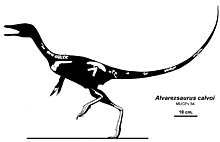Alvarezsaurus
| Alvarezsaurus calvoi Temporal range: Late Cretaceous,
| |
|---|---|

| |
| Skeleton restoration | |
| Scientific classification | |
| Domain: | Eukaryota |
| Kingdom: | Animalia |
| Phylum: | Chordata |
| Clade: | Dinosauria |
| Clade: | Saurischia |
| Clade: | Theropoda |
| Family: | †Alvarezsauridae |
| Genus: | †Alvarezsaurus Bonaparte, 1991 |
| Species: | †A. calvoi
|
| Binomial name | |
| †Alvarezsaurus calvoi Bonaparte, 1991
| |
| Synonyms | |
| |
Alvarezsaurus (/ˌælvərɛzˈsɔːrəs/; "Alvarez's lizard") is a genus of small alvarezsaurid dinosaur from the Late Cretaceous period, living in Argentina, approximately 86 - 83 million years ago. Estimates suggest that it measured about 2 meters (6.5 ft) in length and weighed approximately 20 kg (45 lbs). Gregory S. Paul estimated in 2010 its weight at 3 kg and length at 1 m.[1] It was found in the Bajo de la Carpa Formation and was named by paleontologist José Bonaparte in 1991 after the historian Don Gregorio Alvarez.[2] The type species is A. calvoi.
Description

Alvarezsaurus was bipedal theropod. Like other lightweight theropods, it had a long tail, and its leg structure suggests that it was a fast runner. The most proximal elements of Alvarezsaurus caudal vertebrae exhibited ventrally sharp centra and the transerve processes of these vertebrae were sub-triangular and laterodistally directed, features seen in other alvarezsaurids like Shuvuuia.[3] Spinal processes were entirely absent or poorly developed, and each caudal vertebra supported short prezygapophyses. The scapula was visibly curved and proportionally smaller than those of other alvarezsaurids, and unlike its relatives Alvarezsaurus did not have a fused astragalus and calcaneum. It was unique in that its metatarsal III was its longest, followed by an unusually long metatarsal IV. It may have been insectivorous.
Classification

Alvarezsaurus is considered basal to better-known members of its family, such as Mononykus and Shuvuuia. It has been alternately classified with both non-avian theropod dinosaurs and early birds, but a move of the alvarezsaurids to be recognized as more closely related to neornithine birds proved controversial despite being supported by earlier studies.[3] It was once believed that the Patagonian alvarezsaur taxa were the most basal of their family, but the discovery of a more basal member, Haplocheirus, disproved that when its fossils were discovered in China.[4]
External links
References
- ^ Paul, G.S., 2010, The Princeton Field Guide to Dinosaurs, Princeton University Press p. 126
- ^ Bonaparte, José F., 1991. ‘’Los vertebrados fósiles de la Formación Río Colorado, de la ciudad de Neuquén y cercanías, Cretácico superior, Argentina.’’. In: Museo Argentino de Ciencias Naturales ‘’Revista del Museo Argentino de Ciencias Naturales ‘’Bernardino Rivadavia’’ e Instituto Nacional de Investigación de las Ciencias Naturales: Paleontología’’ 4(3): 17-123.
- ^ a b Chiappe, Luis M., Norell, Mark A., Clark, James M., 2002. ‘’The Cretaceous, Short-Armed Alvarezsauridae ‘’Mononykus and Its Kin’’ In: Chiappe, Luis M., Witmer, Lawrence M. Mesozoic Birds: Above the Heads of Dinosaurs Pp 87-120
- ^ Choiniere, J.N.; X. Xu; J.M. Clark; C.A. Forster; Y. Guo; F. Han 2010. ‘’A Basal Alvarezsauroid Theropod from the Early Late Jurassic of Xinjiang, China’’ Science 327: 571-574.
